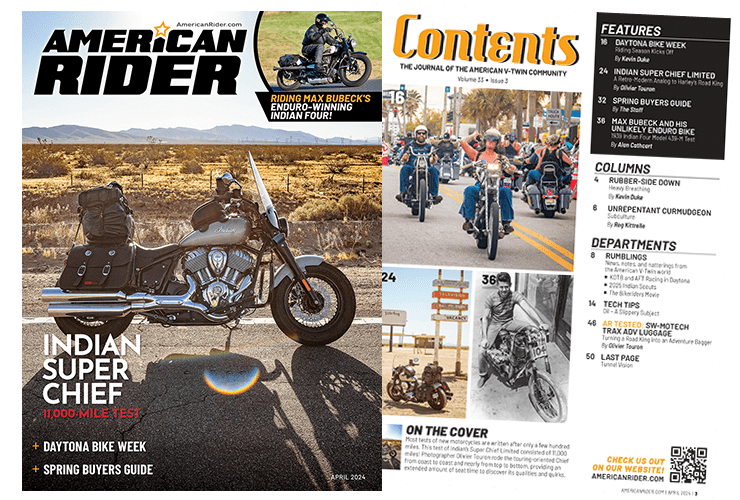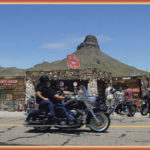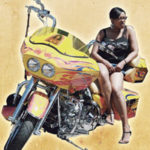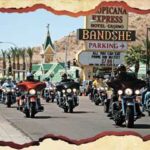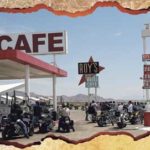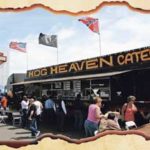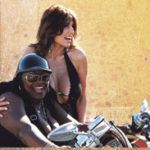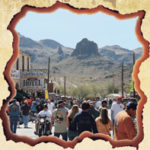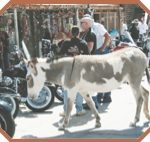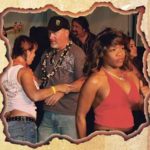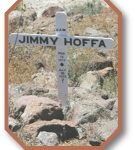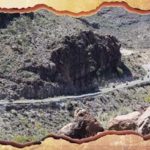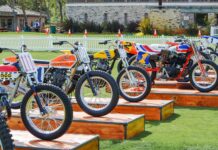Living large on less
Laughlin delivers the upside of the downturn
Laughin, Nevada, Apr. 23–26—As the economy sours, the River Run experience just gets sweeter, with more reasonable prices, more reasonable room availability, more reasonable crowd size, more accessible bike parking, more fluid traffic flow, and more understated police presence. That’s a trend that was perceptible at last year’s event, as things were taking a turn for the frugal, and one that has accelerated in 2009 as River Run producers Dal-Con Promotions, their consortium of participating hotel/casinos, and the business community of Laughlin generally, adapted to the uncertainties presented by the recession, especially the big question mark looming over event attendance.
The result is an affair that’s scaled down—but not glaringly so. The turnout is more than respectable (greater, frankly, than anyone had cause to anticipate) and those in attendance discover that the main ingredients that have come to characterize the River Run—a multitude of vendors, top name entertainers, a pair of poker runs, a custom bike show, beauty pageant, and acres of diverse American iron—remain intact. They’re just easier to access. It’s also easier to park wherever you’re staying and wherever you’re going, and easier to cruise into and out of town, thus making day rides during the event a real breeze rather than the hot idling frustration of years past.
Signs of the times en route
While the city of Laughlin is the locus and namesake of the event, it would be just as accurate to call it the Mother Road Run since you’re liable to be on or within a short distance of vestiges of fabled Route 66 for much of your saddle time in getting there and riding around the regional hotspots, or, equally aptly, the Mojave Desert Run, since in practice the deal spills all over the starkly beautiful region from Mojave, California, to Kingman, Arizona. For many of us, it’s that broader sense of what the run represents that makes it such an attractive destination, and especially this year when I found myself looking to that long ride in the desert as a much-needed mental escape from the pall of dire economic reality. But there is no escape. The signs of the malaise crop up unsettlingly along the route, starting in Mojave. That windblown old railroad town is perhaps best known to travelers for its mothballed fleet of aircraft, stashed out in the desiccated wastes to await return to service or a long, slow dissipation to sun-bleached scrap metal. Always riveting, in a dinosaur bone pile sort of way, this year the forlorn collection has grown substantially, and added a much better class of aircraft as rows of late-model commercial passenger jets stand in silent testimony to the most precipitous drop-off in airline travel in history. Sigh.
Leaving Mojave, the next signs of hard times are the rest areas at both Boron and Newberry Springs, which have been convenient way stations on the ride to Laughlin in the past—ideal spots for a good stretch and a good spell of desert reverie—but are now closed for repairs that aren’t being made owing to the California budget crunch.
Following the original stretch of Mother Road that strikes off east from Ludlow, I arrive in the historic and ghostly town of Amboy, the woebegone outpost best known for Roy’s Motel and Café. That establishment, with its famous atomic-era “raygun gothic” sign, has been a landmark on 66 for generations, serving as a popular stop along the route before being bypassed by Interstate 40 to the north, and then as a film location for various projects including the Rutger Hauer horror chest nut, The Hitcher. Years of neglect had brought the place to a low state, resulting in its closure in 2005. Happily, it was reopened and the gas pumps were flowing in time for last year’s River Run, having been purchased and partially refurbished by restaurant chain magnate and preservationist Albert Okura. Okura’s plans at the time of purchase were to bring Roy’s back to its former glory as a motel, café and store, and to add a museum and gift shop to the mix. That’s an ambitious undertaking even in good times. In hard times, it’s unrealistic, and the progress made towards that end is modest. This year the gas still flowed, and the café area put in order and into use selling souvenirs and cold drinks, but not a whole lot more has been accomplished. Nonetheless, scores of riders made their traditional stop there, and even though the place is without an alcoholic beverage license of any kind, cold beer was being offered for free—donations accepted. A gallon of hi-test cost $2.99, down from $4.69 a year ago, reflecting the only positive note in an otherwise dismal economy.
(On a sour side note, anyone who’s fond of Amboy and its environs—which include the nearby Amboy Crater National Natural Monument and the Amboy shoe tree up the road apiece—will find it as alarming as I do that the Marine Corps is currently angling to annex a chunk of land to their Twenty Nine Palms training facilities in the vicinity, and should it come to pass, the entire historic stretch of Route 66 that includes all of the aforementioned attractions will become off-limits to the public.)
Hitting the old haunts
Friday morning I leave my digs at the Edgewater Hotel, strolling out through the VIP parking beneath the porte cochere, and then 20 yards to my bike. Unbelievable. It’s hard not to crack a smile recalling times in the past when it would take a nerve-wracking, head-scratching, half-hour search to locate my ride in a distant sea of machinery. I load up and head from there over to the Tropicana Express for the staging of the annual American Heroes Foundation Charity Poker Run. This worthy event raises money for a variety of charitable causes benefiting veterans, and reliably draws a good number of charitable souls who pony up $10 for the ride over Route 66 to Mother Road Harley-Davidson in Kingman. Seeing as how I’ve never won a red cent at a poker run in my entire sorry two-wheeled career, and have lost all hope in that regard, I ride out ahead of the official 10:00 starting time and scoot straight up to funky Oatman, Arizona, the River Run’s principal ride-to destination and satellite party zone. There I discover to my delight that there is not the usual gridlocked swarm of pedestrian, vehicular, and feral burro traffic I’ve come to expect in that popular River Run destination. There’s a lively crowd, for sure, and a pair of insouciant burros lollygagging in the street, but I find a parking spot right in the middle of town without a fuss—a first for me. I also find a seat at the bar of the Oatman Hotel, which is another first.
The Oatman Hotel is a famous place in these parts, and is listed on the National Register of Historic Places. Established in 1902 and serving as the town’s premiere hospitality establishment throughout the heyday of the surrounding gold mines, as well as during Oatman’s resurgence as a principal stop along old Route 66, the hotel has a long and colorful history. Its principal claim to fame, the one that keeps the tourists rolling in, is that Clark Gable and Carole Lombard spent their honeymoon night in one of its rooms in 1939 after having wed in nearby Kingman. That’s the legend, anyway, but it appears now that that claim may, in fact, be nothing more than an oft-repeated and widely-published canard, and that the couple actually drove straight home to Hollywood where they awakened the following morning to an army of reporters, photographers, and newsreel crews eager for a sensational story on the Brangelina of the era. (This is according to an interview with Clark Gable published in the February 1940 edition of Photoplay, and reprinted at www.carolelombard.org)
Be that as it may, the Oatman Hotel remains a historic jewel that oozes rustic charm, authenticity and eccentricity. The walls are famously papered with dollar bills pinned up by past patrons marking their passage, the food and service the best (and virtually only) in town, and the place is allegedly haunted. (Though, from what we know now, the alleged connubial laughter of Clark and Carole is more likely the braying of a road-kill burro.)
It’s at Oatman that the road up from Laughlin has joined old Route 66, and the way down from there to Kingman is a long, constricted corkscrew of worn asphalt through a magnificently harsh landscape and breathtaking desert mountain vistas, and as many times as I’ve traversed the route, there are still surprises to be discovered. This time it’s at a pull-off area on a promontory overlooking the twisting road below and the distant valley of the Colorado River, a place I’ve stopped many times over the years to take photographs. This year I walk out farther onto the overlook than before and discover the gravesite of Jimmy Hoffa. Seriously. At least that’s what the cross marker says. It’s probably another canard, but all around it are other simple markers stuck in the rocky ground with more credible inscriptions. What we appear to have here is a burial ground for the cremains of the local departed, and it’s hard to imagine a more picturesque spot to spend eternity.
(It should be noted here, since we’re ticking off signs of the times, that money from the recently enacted stimulus package will be used to repair this section of old Route 66—all the way from Kingman to Golden Shores. For those who are Mother Road enthusiasts—and who isn’t?—that’s truly exciting news. It’s too bad the same treatment can’t be given to the stretch of 66 from Newberry Springs to Ludlow in California, which is battered to the point of ruination, and fading fast.)
Upon arriving in Kingman, it’s good to see that the old downtown section of Route 66—or Andy Divine Boulevard, as it’s designated in town—has a goodly number of scooters parked at the Powerhouse Museum and out front of the old bars and diners nearby. There’s also a good-sized crowd at Mother Road Harley-Davidson, which is once again hosting their own River Run weekend doings. While the doings are not as extensive as a year ago, there’s nonetheless the county fair atmosphere the event has become known for, complete with a midway of food booths offering up fair fare, and a big shady tent with tables and chairs, a bar and a bandstand. It’s a great place to just hang and while away the afternoon before heading back to Laughlin by way of Route 68 and the town of Golden Valley, home to the Cattle Crossing Saloon, bar-none the best and most overlooked biker bar in the region.
Walking the walk
Continuing another trend from last year’s River Run, this year’s event enjoys near-perfect weather, with temperatures rising no higher than the low 90s on Thursday and Friday, and dropping steeply from there on Saturday with the arrival of a cold front. That type of change usually brings with it some sort of weather mischief, but the predicted arrival of the fierce winds Laughlin is notorious for doesn’t transpire, and Saturday dawns pleasantly cool. It never heats up past 77 degrees, making it the perfect day for doing my annual Casino Drive vendor stroll.
Laughlin has long held the title as the country’s biggest open-air biker bazaar, stretching across the asphalt plain fronting the casinos from the Riverside to the River Palms, and it doubtless retains that title, but the vendor population has declined appreciably over the last two years. The total of just over 200 registered booths this year is but half of the pre-recession 2007 figure. No surprise there, but also no shortage of stuff to do and see and buy, anyway. There is, however, a shortage of demo rides as Harley-Davidson’s demo fleet, which had been a fixture of the run for many years, is a no-show.
There’s a big upside in all of this, though, in that it’s that reduction of vendor booth space that explains the welcome ease of parking in close proximity to the hotels and outdoor activities. Additionally, space has been freed up for another welcome development of the River Run, that of more street-side party zones. Where once only the Tropicana Express offered party facilities right there in the thick of the Casino Drive strip (and this year charged ten bucks to sit there), now both the Aquarius and Edgewater boast the same. There’s big fun to be had at both venues as well as the established parking lot party tents at the Pioneer, where the mechanical bull riding and mud wrestling are perennial crowd pleasers, and at the Colorado Belle where the Center Circle Area stages the run’s best free music daily, and which was again this year the most popular patch of shade on the strip.
Walking through the doors of the various casinos along the way offers some other evidence of how the River Run—and Laughlin in general—has adapted to stern economic realities. For one thing, you’re no longer greeted at each entry by prominent “No Colors” signage. It’s easy to assume that patch wearers might still find themselves uncomfortably scrutinized, but just as easy to assume that Laughlin, in its own subtle way, wants to dispense with any overt reminders of 2002, lest they continue to have a chilling effect on the turnout. (The notable exception to this is Harrah’s, which continues to fly their “We Support a No Colors Policy” banners, but then, incredibly, they’re still dealing with a lawsuit stemming from the infamous 2002 melee.)
The other striking adaptation to current economic conditions made by the Laughlin casinos (and reportedly casinos nationwide as well) is the wild proliferation of penny slot machines on the gaming floors. Once relegated to dark corners in the back of the room, massive banks of the low-budget bandits now greet gamblers at the door. Fully a quarter of all gambling revenue in Nevada is now accounted for by these humble devices, but don’t bother hauling in your sacks of loose coppers to play them. They’re “paper-only” machines—just bills or casino vouchers, please.
Lovable Laughlin
For many River Run veterans, myself included, the most welcome feature of the Laughlin austerity program is the relatively light law enforcement resources in evidence this year. It’s a refreshingly sensible change from past practices and one you can attribute directly to the collapsed tax base and fiscal crisis of Clark County—among the hardest hit areas in the country. In spite of that draw-down—or, arguably, because of it—this year’s event comes off without an incident any more serious than your garden variety DUI, and without a single traffic fatality. Combine that with the other biker-friendly elements in play this year and you get the unlikely upshot that the Laughlin River Run now rates up in the top tier on my fave rally list. Scenery, history, desert sun, camaraderie, entertainments alore—it’s got it all, and at affordable prices with minimal hassles. And while it’s true that in terms of sheer magnitude, the run is but a shadow of its former self, it’s just as true that in the Mojave, a shadow is a welcome thing.

